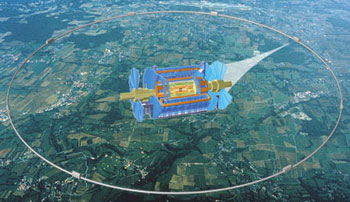You should read about:
-
High Energy Physics (HEP) or Particle Physics which is the study
of elementary constituents of matter and of their interactions.
-
Our present knowledge about the structure of matter tells us that
the matter is composed of tiny constituents, the Elementary particles.
-
Elementary particles
The elementary particles are divided into:
-
Hadrons
Out of these hundreds of hadrons (which you should learn that
are not fundamental) you will be asked to study a few (protons,
pi-mesons).
-
Leptons
Out of the few leptons (which are fundamental) you will be asked
to study the muons, electrons and neutrinos.
The Elementary particles interact between themselves by exchange of the
carriers of the four forces. The particles and forces are described by
the Standard Model (SM). The carriers of the so called "weak interaction"
are the:
-
Z and W particles - these particles you will see "live" and reconstruct
in the ATLAS detector.
-
There is a particle predicted by this model which has NOT been detected up
to now. The Higgs particle which you will try to discover.
There are other theories (example the Supersymmetry) which try to solve some of
the problems of the Standard Model but predict more new particles (which ATLAS
will detect if they exist).
|

|

|
In order to detect all the above particles and more, one needs:
-
A powerfull enough accelerator to create them. And CERN is building one, the LHC
-
A giant detector consisting of various specialized parts to detect them, and ATLAS is such
First learn about Detectors for HEP experiment:
-
How the different particles interact with a HEP detector
-
Tracking detector
-
Particle identification
-
Magnets for momentum measurement
-
Calorimeters
-
Muon detectors
|

|
And then learn more about the ATLAS Detector:
-
Inner detector
-
Calorimeters (Electromagnetic and Hadronic)
-
Muon Spectrometer
-
Magnet system
-
Trigger and Data acquisition
|


